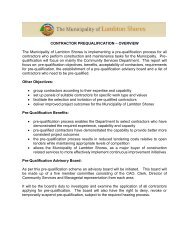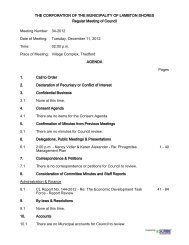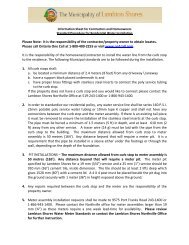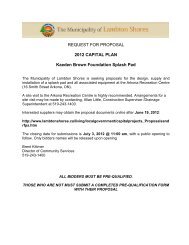View - The Municipality of Lambton Shores
View - The Municipality of Lambton Shores
View - The Municipality of Lambton Shores
Create successful ePaper yourself
Turn your PDF publications into a flip-book with our unique Google optimized e-Paper software.
Container Freight Rates To Rise By Half?<br />
Container freight rates on trans-Pacific services from Asia to the USA could rise 50% by<br />
May this year if shipping lines succeed in pushing through planned rate increases,<br />
according to the South China Morning Post.<br />
Fifteen container shipping lines belonging to the Transpacific Stabilisation Agreement<br />
(TSA) have recommended rate increases <strong>of</strong> US$ 400 per 40-foot container to US west<br />
coast ports and US$ 600 per FEU to all other US destinations from April. Carriers like<br />
the Tung-family controlled Orient Overseas Container Line and Cosco Container Lines<br />
are advocating increases <strong>of</strong> US$ 800 per FEU for cargo shipped to the west coast and up<br />
to US$ 1200 per FEU from Asia to other US cities.<br />
Barclays Bank industrial analyst Jon Windham says container lines have been only<br />
partially successful in lifting freight rates as cargo owners have resisted paying the full<br />
increases sought. He estimates that cargo demand will rise by 6.3% this year while fleet<br />
growth will lag behind at 5.8%, thus helping to ‘buoy’ freight rates. <strong>The</strong> latter figure<br />
contrasts with the 9% growth in container ship capacity forecast by Alphaliner for this<br />
year.<br />
TSA’s Executive Administrator Brian Conrad comments: ‘It is essential to carriers’ longterm<br />
viability that new contracts include rates that are more closely aligned with current<br />
market levels.’<br />
Will A Shortage Of Fiber Harm <strong>The</strong> Global Paper Recycling Industry?<br />
A review <strong>of</strong> assessments by paper industry analysts shows growing concern about the<br />
potential inability <strong>of</strong> the recycling industry in developed countries to supply enough fiber<br />
to feed new demand in the developing world.<br />
<strong>The</strong> key issue being debated by analysts in reports and presentations is the theoretical<br />
limits to expanded recovery. For example, while the current fiber recovery level in the<br />
U.S. is at a highly commendable 67 percent, this is actually below levels elsewhere.<br />
"Japan has the highest recovery rate in the world at about 77 percent," says Bill Moore <strong>of</strong><br />
Moore and Associates. He notes that the Netherlands, Austria and Germany have similar<br />
rates. Moore says that Japan topped at 80 percent before falling back. "Thus, I would say<br />
80 percent is a good theoretical maximum."<br />
Hannah Zhao, an economist with RISI, agrees. "Although we don't know the exact limit<br />
on how high the paper recovery can go, we are almost sure that 80 percent is very close<br />
to the limit," she concludes. She points out that all <strong>of</strong> Western Europe, including the three<br />
countries listed by Moore, has a combined recovery level <strong>of</strong> about 75 percent.<br />
At the same time, demand for recovered fiber continues to rise in the developing world.<br />
Zhao points out that China added 6.6 million tons per year <strong>of</strong> new paper and paperboard<br />
capacity last year. While some <strong>of</strong> these new machines replaced old, inefficient ones,<br />
China's demand for bales continues upward.<br />
7
















